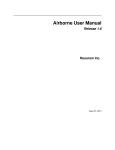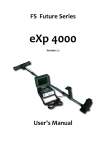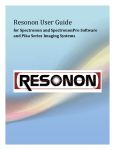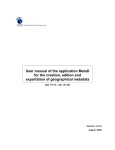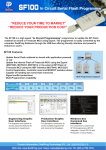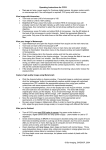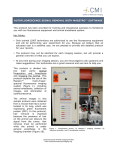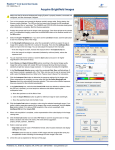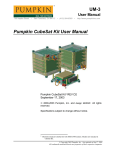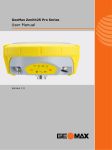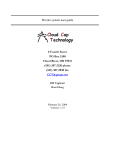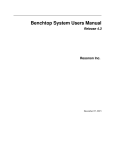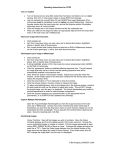Download Airborne User Manual
Transcript
Airborne User Manual
Release 1.7
Resonon Inc.
August 03, 2015
CONTENTS
1
Introduction
1.1 Data Modes . . . . . . . . . . . . . . . . . . . . . . . . . . . . . . . . . . . . . . . . . . . . . . . .
1
1
2
Installation
2.1 System Hardware . . . . . . . . . . . . . . . . . . . . . .
2.2 Installing the Hardware . . . . . . . . . . . . . . . . . .
2.3 Configuring the SBG Ellipse . . . . . . . . . . . . . . . .
2.4 Installing and Connecting to the Ground Station Software
2.5 Installing drivers for reading Ext4 drives in Windows . . .
.
.
.
.
.
.
.
.
.
.
.
.
.
.
.
.
.
.
.
.
.
.
.
.
.
.
.
.
.
.
.
.
.
.
.
.
.
.
.
.
.
.
.
.
.
.
.
.
.
.
.
.
.
.
.
.
.
.
.
.
.
.
.
.
.
.
.
.
.
.
.
.
.
.
.
.
.
.
.
.
.
.
.
.
.
.
.
.
.
.
.
.
.
.
.
.
.
.
.
.
.
.
.
.
.
.
.
.
.
.
.
.
.
.
.
3
3
3
8
8
9
Using the Airborne Spectral Imaging System
3.1 Powering Up the Flight Computer . . . .
3.2 Launching the Software . . . . . . . . .
3.3 Refresh Now Button . . . . . . . . . . .
3.4 Home Tab . . . . . . . . . . . . . . . .
3.5 Flight Tab . . . . . . . . . . . . . . . . .
3.6 Imager Tab . . . . . . . . . . . . . . . .
3.7 GPS/IMU Tab . . . . . . . . . . . . . .
3.8 Computer Tab . . . . . . . . . . . . . .
3.9 Storage Tab . . . . . . . . . . . . . . . .
3.10 Targets Tab . . . . . . . . . . . . . . . .
3.11 Command Line . . . . . . . . . . . . . .
3.12 Menu Items . . . . . . . . . . . . . . . .
3.13 Transferring Data . . . . . . . . . . . . .
3.14 Post Processing Data with Spectronon . .
3.15 Using GeoReg . . . . . . . . . . . . . .
.
.
.
.
.
.
.
.
.
.
.
.
.
.
.
.
.
.
.
.
.
.
.
.
.
.
.
.
.
.
.
.
.
.
.
.
.
.
.
.
.
.
.
.
.
.
.
.
.
.
.
.
.
.
.
.
.
.
.
.
.
.
.
.
.
.
.
.
.
.
.
.
.
.
.
.
.
.
.
.
.
.
.
.
.
.
.
.
.
.
.
.
.
.
.
.
.
.
.
.
.
.
.
.
.
.
.
.
.
.
.
.
.
.
.
.
.
.
.
.
.
.
.
.
.
.
.
.
.
.
.
.
.
.
.
.
.
.
.
.
.
.
.
.
.
.
.
.
.
.
.
.
.
.
.
.
.
.
.
.
.
.
.
.
.
.
.
.
.
.
.
.
.
.
.
.
.
.
.
.
.
.
.
.
.
.
.
.
.
.
.
.
.
.
.
.
.
.
.
.
.
.
.
.
.
.
.
.
.
.
.
.
.
.
.
.
.
.
.
.
.
.
.
.
.
.
.
.
.
.
.
.
.
.
.
.
.
.
.
.
.
.
.
.
.
.
.
.
.
.
.
.
.
.
.
.
.
.
.
.
.
.
.
.
.
.
.
.
.
.
.
.
.
.
.
.
.
.
.
.
.
.
.
.
.
.
.
.
.
.
.
.
.
.
.
.
.
.
.
.
.
.
.
.
.
.
.
.
.
.
.
.
.
.
.
.
.
.
.
.
.
.
.
.
.
.
.
.
.
.
.
.
.
.
.
.
.
.
.
.
.
.
.
.
.
.
.
.
.
.
.
.
.
.
.
.
.
.
.
.
.
.
.
.
.
.
.
.
.
.
.
.
.
.
.
.
.
.
.
.
.
.
.
.
.
.
.
.
.
.
.
.
.
.
.
.
.
.
.
.
.
.
.
.
.
.
.
.
.
.
.
.
.
.
.
.
.
.
.
.
.
.
.
.
.
.
.
.
.
.
.
.
.
.
.
.
.
.
.
.
.
.
.
.
.
.
.
.
.
.
.
.
.
.
.
.
.
.
.
.
.
.
.
.
.
.
.
.
.
.
.
.
.
.
.
.
.
.
.
.
11
11
11
12
12
13
14
16
18
20
20
23
23
25
25
28
Operation Summary and Checklist
4.1 Mission Setup . . . . . . . . . . .
4.2 Pre Flight . . . . . . . . . . . . . .
4.3 Flight (All operations are optional)
4.4 Post Flight . . . . . . . . . . . . .
4.5 Data Files and Structure . . . . . .
4.6 Keys to Obtaining Quality Data . .
.
.
.
.
.
.
.
.
.
.
.
.
.
.
.
.
.
.
.
.
.
.
.
.
.
.
.
.
.
.
.
.
.
.
.
.
.
.
.
.
.
.
.
.
.
.
.
.
.
.
.
.
.
.
.
.
.
.
.
.
.
.
.
.
.
.
.
.
.
.
.
.
.
.
.
.
.
.
.
.
.
.
.
.
.
.
.
.
.
.
.
.
.
.
.
.
.
.
.
.
.
.
.
.
.
.
.
.
.
.
.
.
.
.
.
.
.
.
.
.
.
.
.
.
.
.
.
.
.
.
.
.
.
.
.
.
.
.
.
.
.
.
.
.
.
.
.
.
.
.
.
.
.
.
.
.
.
.
.
.
.
.
.
.
.
.
.
.
.
.
.
.
.
.
.
.
.
.
.
.
.
.
.
.
.
.
.
.
.
.
.
.
31
31
31
31
32
32
32
Advanced Operation
5.1 Sending Special Commands to the Flight Computer
5.2 Connecting the Flight Computer to a Network . . .
5.3 Updating Firmware . . . . . . . . . . . . . . . . . .
5.4 Pairing a New Imager with the Flight Computer . .
5.5 Pairing a GPS/IMU with a Flight Computer . . . . .
.
.
.
.
.
.
.
.
.
.
.
.
.
.
.
.
.
.
.
.
.
.
.
.
.
.
.
.
.
.
.
.
.
.
.
.
.
.
.
.
.
.
.
.
.
.
.
.
.
.
.
.
.
.
.
.
.
.
.
.
.
.
.
.
.
.
.
.
.
.
.
.
.
.
.
.
.
.
.
.
.
.
.
.
.
.
.
.
.
.
.
.
.
.
.
.
.
.
.
.
.
.
.
.
.
.
.
.
.
.
.
.
.
.
.
.
.
.
.
.
.
.
.
.
.
.
.
.
.
.
35
35
35
36
36
37
3
4
5
.
.
.
.
.
.
.
.
.
.
.
.
.
.
.
.
.
.
i
5.6
5.7
5.8
5.9
5.10
ii
Pairing/Unpairing a Downwelling Irradiance sensor with a Flight Computer
Reformatting Disks . . . . . . . . . . . . . . . . . . . . . . . . . . . . . .
Uploading Error Logs . . . . . . . . . . . . . . . . . . . . . . . . . . . .
Changing Default Cube Length . . . . . . . . . . . . . . . . . . . . . . .
Troubleshooting . . . . . . . . . . . . . . . . . . . . . . . . . . . . . . .
.
.
.
.
.
.
.
.
.
.
.
.
.
.
.
.
.
.
.
.
.
.
.
.
.
.
.
.
.
.
.
.
.
.
.
.
.
.
.
.
.
.
.
.
.
.
.
.
.
.
.
.
.
.
.
.
.
.
.
.
.
.
.
.
.
.
.
.
.
.
37
37
37
38
38
CHAPTER
ONE
INTRODUCTION
The Resonon Airborne Spectral Imaging System is a compact, high fidelity, digital imaging spectrometer for airborne
applications. The system consists of a Pika imaging spectrometer, a Flight Computer, a GPS/IMU, an optional downwelling irradiance sensor, an optional external USB LCD display, Spectronon data analysis software, and the Resonon
Ground Station software.
This User Manual covers the installation and use of the hardware and software. Topics covered in this manual include:
• Installing the Spectral Imaging Hardware
• Installing and Configuring the Ground Station Software
• Configuring the Airborne Spectral Imaging System
• Flight Operations, Data Download, Georectification
1.1 Data Modes
Airborne hyperspectral data from the Resonon imaging system can be utilized in three forms, as summarized below.
Raw data: This data is spectrally calibrated but contains the instrument response and illumination functions. This is
the least useful form, as the spectral curves do not have real units or real physical meaning.
Radiance: The data can be post-processed to radiance. This requires the imager to be specially calibrated by Resonon
at the desired aperture. This data form does not include the instrument response function. It has the advantage of
possessing real units and physical meaning. If you have the calibrated radiance cube provided by Resonon, post-flight
correction can be performed by using the Radiance Conversion tool in Spectronon.
Reflectance: In reflectance mode, both the instrument and illumination functions are removed. This leaves the data in
absolute Reflectance. Data can be converted to Reflectance with one of four ways:
• White reference pre or post flight: Data can be processed to Reflectance with a quick calibration against
a reflection standard, pre or post flight. The highest quality reflection standard is Spectralon, but Teflon is
acceptable for many applications (Note: Teflon needs to be sanded with 100 grit sandpaper on an orbital sander
to eliminate any specular properties). This calibration is done with the Record Correction Cube feature, as
described later in this document. It is important to note that Reflection values are only accurate if the solar
illumination (clouds, sun angle, etc) does not change between the collection of the correction cube and the
collection of datacubes. Data can be converted to Reflectance using Spectronon’s Correct from Cube plugin.
• Known spectral reference in scene: Once the data is in radiance, the spectrum of a reference object in the
scene can be used to correct the rest of the cube. The reference spectrum must be known and in a tab or space
delimited file, then use the Correct from Spectrum plugin in Spectronon to convert the data.
• Downwelling Irradiance sensor: The recommended method for converting data to Reflectance is to use a
Downwelling Irradiance sensor. This sensor records the solar spectrum during flight. This data is used, along
1
Airborne User Manual, Release 1.7
with radiometric calibration files supplied by Resonon for both the spectral imager and downwelling sensor, in
the Reflectance Conversion plugin for Spectronon.
• Atmospheric Correction: Data can be converted to Reflectance data with the use of atmospheric correction
algorithms such as FLAASH (Fast Line of Sight Atmospheric Analysis of Spectral Hypercubes). Please contact
Resonon for more information.
2
Chapter 1. Introduction
CHAPTER
TWO
INSTALLATION
2.1 System Hardware
The Resonon Airborne Spectral Imaging system includes:
• Pika imaging spectrometer. This may be:
– Pika IIg VNIR Gigabit Ethernet spectrometer
– Pika XC VNIR Gigabit Ethernet spectrometer
– Pika NIR spectrometer with iPort external frame grabber
• Resonon flight computer
• 2 1/2” SSD hard disk with SATA - USB3 adapter
• GPS/IMU
• Downwelling irradiance sensor (optional)
Resonon provides ground station software to connect to and configure the flight computer. This requires a computer
with:
• Windows 7
• 512MB of RAM
• Serial Port or USB->Serial Adapter
• Null modem serial cable or adapter
2.2 Installing the Hardware
The Spectral Imaging hardware should be mounted in the airframe with the following considerations:
2.2.1 Installing the Spectral Imager
• The Pika should be sighted straight down through the airframe, preferably with a protective window for bellylanded UAVs. If the Pika has a turning mirror mounted, the “cone” of the turning mirror can face forwards or
backwards relative to the direction of flight. The Pika should be square with respect to the GPS/IMU system
(there should be zero angle in pitch, roll, and yaw between the two).
• The Pika should be mounted in a manner to reduce high frequency vibrations, but rigidly to low frequency
vibrations with respect to the GPS/IMU.
3
Airborne User Manual, Release 1.7
Fig. 2.1: Standard system components
Fig. 2.2: Pika NIR imager with external frame grabber
4
Chapter 2. Installation
Airborne User Manual, Release 1.7
Fig. 2.3: Computer front panel
Fig. 2.4: Computer rear panel
2.2. Installing the Hardware
5
Airborne User Manual, Release 1.7
• Do not attempt to adjust aperture (F#) of the Pika or the radiometric calibration will be void.
An example of the Pika installed in a cylindrical fuselage is shown in Fig. 2.5 with an arrow indicating the direction
of flight.
Fig. 2.5: Pika installed in a cylindrical fuselage
Connecting the Pika IIg and Pika XC GigE imagers
• Pika IIg and Pika XC GigE imagers connect to the Flight Computer via a Cat6 Ethernet cable. Use the port on
the Flight Computer closest to the sound jack, as shown in Fig. 2.3.
Warning: Pika GigE imagers must be connected to the correct ethernet port on the flight computer. See “GigE Imager Connection” in Fig. 2.3.
Connecting the Pika NIR imager
• Connect the Pika NIR CameraLink port to the iPort external frame grabber with the provided CameraLink cable.
• The frame grabber USB connection must be made to the USB 3.0 port on the front face of the flight computer,
directly above the hard disk USB port.
Warning: It is critical to connect the frame grabber to the USB 3.0 port on the computer front
panel, directly above the hard disk USB 3.0 port. See “Front-panel USB 3.0” in Fig. 2.3.
• The Pika NIR camera must also be connected via USB cable to the flight computer. Use either the USB 3.0 port
or the USB 2.0 port on the computer rear panel. See Fig. 2.4.
6
Chapter 2. Installation
Airborne User Manual, Release 1.7
Note: NIR systems may require a USB hub if all possible hardware is installed. The camera USB
connection and the external LCD may be made to a USB 2.0 or USB 3.0 hub. The SSD hard disk,
the external frame grabber, and the GPS/IMU must not be connected to a USB hub.
2.2.2 Installing the GPS/IMU
• The Ellipse, by default, should be mounted with the labeled Z arrow pointed nadir and the X arrow pointed in
the direction of flight. The edges of the unit should be as parallel as possible with the airframe, and the Pika.
There are alignment holes in the base of the Ellipse that can be used to align the unit to reference pins. See the
Ellipse user manual for the location of these holes.
• The unit should be vibration isolated, if possible, but in the same inertial frame as the Pika. The GPS antenna
should be screwed into the appropriate SMA terminal, and the antenna itself should be mounted with a clear
view of the sky. Use brass screws to mount the unit. The unit should be positioned as far away from any potential
source of magnetic interference as possible.
• GPS reception is sensitive to electro-magnetic interference (EMI). The GPS antenna should be placed as far
as possible away from radios, other GPS antennas, the Flight Computer, spark plugs, and any other potential
source of EMI. Try to avoid running the GPS antenna parallel to other wires or cables for much distance. A
ground plane under the antenna helps significantly. Connect GPS antenna to GPS/IMU unit.
• Connect the Ellipse USB cable to any of the USB ports of the Flight Computer. If using a GPS/IMU with a DB9
serial connection, connect the serial cable to COM1 of the Flight Computer. See “Ground Station Connection”
in Fig. 2.4.
2.2.3 Installing the Flight Computer
• The Flight Computer needs airflow- do not completely enclose the unit or block airflow around it.
• Keep power cables to the Flight Computer as short as possible. The unit draws a substantial amount of current
at boot- long cables or wires of too small a gauge can prevent the computer from booting.
• The external USB LCD display is used to diagnose any errors with the system. It is optional. If used, connect
to USB port of Flight Computer.
Note: The external LCD can be connected and disconnected at will while the flight computer is running.
• Mount external SSD in an accessible location. Velcro is useful for mounting, as the drive is removed from the
aircraft for data downloading. Connect the drive’s USB cable to the Flight Computer’s USB 3.0 port that is
labeled ‘Drive’. See “Hard Disk Connection” in Fig. 2.3.
Warning: It is very important to plug the drive into the correct USB port. See “Hard Disk Connection” in
Fig. 2.3.
2.2.4 Installing the Downwelling Irradiance Sensor
• The optional downwelling irradiance sensor’s fiber input needs to be mounted straight-up with a clear, unobstructed view of the sky. Do not excessively bend the optical fiber. The NIR downwelling sensor CANNOT be
placed under plexiglass/polycarbonate, as it is not transparent in that spectral range. Ideally, the fiber head is
exposed to direct light.
• Connect the sensor to the Flight Computer via USB.
2.2. Installing the Hardware
7
Airborne User Manual, Release 1.7
Once all components are installed, provide power to all components of the system (Pika, Flight Computer, and
GPS/IMU), paying close attention to min/max voltages and current requirements.
Device
Pika IIg
Pika XC
Pika NIR
Flight Comp.
MicroINS
Novatel IGM
Voltage
8-30V
5-24V
12V
9-35V
9-18V
10-30V
Power
3W
8W
60W
30W
3W
3W
2.3 Configuring the SBG Ellipse
2.3.1 Antenna Lever Arm Adjustment
The position of the antenna relative to the body of the Ellipse needs to be entered in to the sbgCenter software. Please
see the Ellipse Configuration manual for instructions on applying this offset.
The ‘Home’ position of the unit can be entered as well to speed satellite acquisition time.
Warning: Do not change any of the Input/Output or Data Output settings while using the sbgCenter.
2.3.2 Magnetometer Calibration
The magnetometer should be calibrated before data collection as well. This can be performed on the ground, or
preferably, in the air. This procedure can be performed with the sbgCenter, or if in the air, with the Resonon Ground
Station software. It has been Resonon’s experience that a 2D calibration is difficult to perform in the air due to the need
to keep the wings level. A 3D calibration is preferable for accuracy reasons and should be performed if possible. Please
see the Magnetic Calibration in Airborne Applications document for instructions on performing these calibrations.
If using the Resonon Ground Station, please see the Ellipse GPS/IMU Magnetic Calibration section in the Operation
chapter of this manual.
If using the sbgCenter sofware, please see the Magnetic Calibration in Airborne Applications document for instructions.
Warning: Do not change any of the Input/Output or Data Output settings while using the sbgCenter.
2.3.3 Microhard Radio Modem
If the optional Microhard radio modems are used to communicate between the Flight Computer and the ground station
computer, a null modem connector must be used between the Flight Computer and the Microhard radio. The modem
will connect to COM2 of the Flight Computer. See “Ground Station Connection” in Fig. 2.4.
2.4 Installing and Connecting to the Ground Station Software
The Resonon Ground Station Software is easily installed with the provided installer. Please uninstall older versions of
the Resonon Ground Station software before installing newer versions, then double click the installer and follow the
instructions.
8
Chapter 2. Installation
Airborne User Manual, Release 1.7
2.4.1 Connecting to Ground Station
The Ground Station software communicates to the airborne system through the Microhard data link or directly through
a serial cable. These options will be discussed in more detail below.
Microhard radios
1. Make sure that the airborne radio is connected to the COM2 port of the Flight Computer using a normal serial
cable and that the radio is properly powered. See “Ground Station Connection” in Fig. 2.4.
2. Connect the second radio to the laptop serial port (or USB->serial adapter) using a normal serial cable. The
Resonon Ground Station software will utilize this serial port, so note the name of this port (COM1, COM2, etc).
The baud rate of this connection is 115.2 k.
3. Launch the Resonon Ground station software. The software will attempt to open the default port (COM1) at the
default baud rate (115.2 k). This will fail unless COM1 is the correct port. In the Comms menu item, set the
correct port. Then select Comms | Connect to establish the connection.
Direct connection
1. Connect the laptop serial port (or USB->serial adapter) to the Comm2 port of the Flight Computer using a
normal serial cable. The Resonon Ground Station software will utilize this serial port, so note the name of this
port (COM1, COM2, etc). The baud rate of this connection is 115.2 k.
2. Launch the Resonon Ground station software. The software will attempt to open the default port (COM1) at the
default baud rate (115.2 k). This will fail unless COM1 is the correct port. In the Comms menu item, set the
correct port. Then select Comms | Connect to establish the connection.
Ground station COM port selection
2.5 Installing drivers for reading Ext4 drives in Windows
The external solid state drive that the data is collected on is formatted as Ext4, which Windows does not natively
support. Therefore drivers are needed. There are a few options (Paragon, Ext2Explore), but the Ext2Fsd drivers seem
to be the best.
1. Download the driver from http://www.ext2fsd.com and install. A reboot is necessary.
2. Plug the drive into your computer and launch Ext2Fsd.
3. Find the drive labeled as Ext4. If no Volume letter has been assigned, right click on the drive entry. Select
Change Drive letter.
4. Select Add, and then Automatic Mount. Select Ok.
5. The drive should be available in Windows for normal file transfer.
2.5. Installing drivers for reading Ext4 drives in Windows
9
Airborne User Manual, Release 1.7
10
Chapter 2. Installation
CHAPTER
THREE
USING THE AIRBORNE SPECTRAL IMAGING SYSTEM
3.1 Powering Up the Flight Computer
If using a laptop or external LCD to monitor the system, connect these devices to the system and then power the system
on. The laptop communication cable connects to COM2 of the Flight Computer. The external LCD connects to a USB
port of the Flight Computer. See Fig. 2.4.
Power up the system. The unit should remain stationary for a few minutes while the GPS/IMU acquires satellites and
initializes. If the external LCD is connected to the flight computer it will display the Resonon logo while the computer
is starting up. It will display system information once the flight computer software is running. Confirm that all systems
are operational in the external LCD (Fig. 3.1).
It is preferred not to turn off power to the system without shutting it down with the Shutdown button on the Computer
Tab of the Ground Station software (Fig. 3.9).
Fig. 3.1: External LCD
3.2 Launching the Software
Launch the Resonon Ground Station software. The controls will be disabled until the imaging system is online and
communicating. If you receive the message dialog “No Response”, there is a communication failure between the
imaging system and the ground station software. This has two likely causes:
1. The system may still be starting. In this case the external LCD displays the Resonon logo. Simply wait for the
system to finish starting (the LCD displays system information) and reconnect from the Comms menu.
2. The serial port may be misconfigured. Navigate to the Comms menu, and try to reconnect with the correct serial
port and baud rate. The default baud rate is 115.2 k.
11
Airborne User Manual, Release 1.7
3.3 Refresh Now Button
The Refresh Now button is used to manually query the Flight Computer for the most recent status and setting information and update the ground station accordingly. This is usually unnecessary unless communications between the
flight computer and ground station have been interrupted.
3.4 Home Tab
Fig. 3.2: The Home Tab
The Home Tab (Fig. 3.2) displays useful information regarding the status of the system.
The Systems section shows the most important status components of the system, to be used as quick visual confirmation that the system is operating properly. This information is mirrored on the external LCD, if it is connected. The
operator should check all fields in this section at startup. See Troubleshooting for information on procedures if any of
these sections are marked Fail in red. The downwelling irradiance sensor (labeled as ‘Single Point’ in the Home tab)
is optional, and the system will operate normally without it.
The Summary section shows temperature of the flight computer and the disk space available.
12
Chapter 3. Using the Airborne Spectral Imaging System
Airborne User Manual, Release 1.7
3.5 Flight Tab
Fig. 3.3: The Flight Tab
The Flight Tab (Fig. 3.3) groups functions that may be useful during flight under a single tab.
View Frame: This function will request and display a raw imager data frame. It is rarely used in normal operation.
It can provide the operator with feedback regarding the exposure settings, but is much harder to interpret than the
Histogram function.
View Last Cube: This function will request and display a highly compressed, greyscale preview of the last cube
recorded.
Note: To download a preview of an imager frame and last cube remotely, the signal strength of the Radio Modem
connection must be high. If the signal strength is low (low Signal To Noise ratio), the command will timeout before
the preview download can be completed.
Frame Stats: This function will request and display the minimum pixel value, maximum pixel value, and average
values for a new frame of data, intended to assist in confirming exposure settings.
Frame Histogram: This function will request and display a histogram of a new imager frame. The histogram feature
is likely the most useful for determining if the correct exposure settings are used. Interpreting this histogram is the
same as any digital image histogram; the height of the bars show the number of pixels for each brightness level.
3.5. Flight Tab
13
Airborne User Manual, Release 1.7
Record: This button will force the system to record a datacube. It will record continuously until the Stop button
is pressed. This allows the operator to record data over an area outside of the defined target areas (discussed in the
Targets Tab section).
Stop: Stops the collection of datacubes, whether the recording was started manually or because the aircraft is inside
of a defined target region. If this function is used to stop the collection of data within a target region, collection will
begin again once the aircraft is back inside a target region.
Record Correction Cube: This button allows the collection of a Correction Cube for use with post-processing data
correction. The cube collected in this step is used to remove the instrument response as well as the illumination
function and leave the data in Absolute Reflectance (more info on post-processing can be found in Post Processing
Data with Spectronon). Before using this function, place a reflectance standard in the field of view of the imager and
in a manner such that the standard is fully illuminated by the sun (no shadows). Use AutoExposure to determine the
gain settings, and then record a correction cube. This cube will be in the flight’s root folder and named to reflect its
purpose.
Run Auto Expose: Runs the auto exposure routine.
Note: Autoexpose will not run while recording a data cube, so that while in very large target areas, drastic changes
in conditions will impact the data.
3.6 Imager Tab
The Imager Tab (Fig. 3.4) contains the settings relevant to the Spectral Imager. The tab title reflects the actual imager
type in use by the flight computer (Pika IIg, Pika NIR or Pika XC).
Shutter: This sets and displays the shutter setting of the imager as a percentage of the maximum exposure time for
the current frame rate. AutoExpose will adjust the shutter upward in preference to adding gain. If there is not enough
light available (as shown by the Frame Histogram button Fig. 3.3), you may need to decrease the framerate to allow
longer exposure times.
Gain: This sets the gain of the imager. If AutoExpose is used, it is not necessary to manually change the gain settings.
It should be noted that excessively high gain settings add noise to the images. AutoExpose will decrease the gain
in preference to decreasing the shutter setting. If AutoExpose is setting the gain above zero, consider decreasing the
framerate to allow for longer exposure times.
Note: The Pika NIR imager does not support a gain setting. When using a Pika NIR, the gain control will not appear.
Framerate: This sets the framerate of the system, and with it the along-track spatial resolution. Use the Resonon
Airborne Calculator to determine optimum frame rate. Slower frames rates mean lower along-track spatial resolution,
but better signal to noise ratios. If the AutoExpose routine returns a “Not Enough Light” warning, or if it sets gain
above zero, the framerate may be lowered to improve signal to noise ratios.
Cross Track Pixels: This sets the cross-track spatial resolution, normally set at its maximum value. Smaller numbers
mean lower cross-track spatial resolution, but increase signal to noise ratios and produce smaller data files.
Bands: This sets the spectral resolution. Lower band numbers increase signal to noise ratios and result in smaller file
sizes, but decrease spectral resolution.
Note: For the Pika II this parameter is 80 for normal operation.
Imager Orientation: This parameter sets the direction of the imager relative to the direction of flight. Set the parameter to Logo Right if the Resonon label side of the imager is facing the right (starboard) side of the plane and Logo
Left is the Resonon label is facing the left (port).
14
Chapter 3. Using the Airborne Spectral Imaging System
Airborne User Manual, Release 1.7
Fig. 3.4: The Imager Tab
3.6. Imager Tab
15
Airborne User Manual, Release 1.7
Auto Expose Settings: The Auto Expose class selection fine tunes the autoexposure routine for a variety of imaging
scenarios. “Normal” is the most versatile and serves as a starting point for most applications. “Darker areas
of Interest” is for bright backgrounds with sparse areas of darker regions of interest (glacier background with sparse,
dark pools of water of interest). “Bright Areas of Interest” is for dark backgrounds with sparse areas of bright regions
of interest (desert background with sparse, bright objects of interest). “Water” is for imaging water or other scenes
containing highly specular reflections (glare).
For custom settings, select the Custom item. The Handle and Target sliders will then become available. The Handle
parameter determines the which percentage brightness image pixel the AutoExposure algorithm will try to force to the
Target percentage value. For instance, a Handle setting of 98% and a Target setting of 90% will try to force the 98th
percentage brightest image pixel to 90% of the maximum brightness value. This would then allow 2 percent of the
image pixels to be brighter than 90% of the maximum value and be in risk of saturation, but also allow the majority
of the scene to possess good signal to noise ratios. In the case of ocean imaging where a high percentage of glint is
probable, a smaller Handle setting might be preferred. These settings can be adjusted fine-tuned by utilizing the Frame
Histogram feature found in the Flight Tab (Fig. 3.3).
An illustration of the Handle and Target settings is shown in figures Fig. 3.5 and Fig. 3.6.
Fig. 3.5: Histogram before autoexpose
Assume a Handle setting of 98%, and a Target of 90%. The imager grabs a frame and analyzes it. It finds the 98th
percentile brightness value to be 3300 out of a maximum 4095 (12 bit resolution = 4095 DN), as shown in Fig. 3.5.
This is 80% of the maximum. Thus, the exposure time is increased or more gain is added and another frame is grabbed
and analyzed. This process repeats until the Target value of 90% is reached, as shown in Fig. 3.6.
3.7 GPS/IMU Tab
The GPS/IMU Tab (Fig. 3.7) shows the information relevant to the GPS/IMU system and serves as a check to the
proper operation of the GPS/IMU system. The tab title reflects the actual imager type in use, commonly the Ellipse.
The Ground Altitude must be set for proper operation. This altitude is the Mean Sea Level (MSL) altitude of the
ground. If set incorrectly, data may not be collected in the desired target regions.
Latitude, longitude, altitude above mean sea level, altitude above ground, current GPS time and current system time
are reported. The flight computer clock is set to UTC and should match the current GPS time. If they are different,
16
Chapter 3. Using the Airborne Spectral Imaging System
Airborne User Manual, Release 1.7
Fig. 3.6: Histogram after autoexpose
Fig. 3.7: The GPS/IMU Tab
3.7. GPS/IMU Tab
17
Airborne User Manual, Release 1.7
press the Refresh Now button to be sure the information shown is the most current. If they still differ, press the Match
System Time to GPS button to set the system clock to the correct UTC time.
When using an Ellipse GPS/IMU, two extra controls appear in the Current Status section of the GPS/IMU tab. The
GPS/IMU Status field mirrors the GPS/IMU field on the Home tab. Possible values are:
1. FAIL, in red. The system did not find the Ellipse or was unable to initialize it. Correct the problem and restart
the flight computer.
2. INITIALIZING, in orange. The Ellipse is activated, but has not yet fixed it’s position and attitude. This will
update automatically when the Ellipse is ready.
3. OK, in green. The ellipse is ready for flight, provided a proper magnetometer calibration has been done.
Warning: A proper magnetomer calibration is mandatory. Even if the GPS/IMU status is “OK”
the Ellipse will not track it’s position correctly without this calibration. Data loss can result! See
Ellipse GPS/IMU Magnetic Calibration below for details.
When using an Athena GPS/IMU, a Get Number of Satellites button appears on the GPS/IMU tab. Press this button
to poll the Athena for the number of currently fixed satellites.
3.7.1 Ellipse GPS/IMU Magnetic Calibration
This feature calibrates the Ellipse GPS/IMUs magnetometer after installation to compensate for any magnetic field
interference.
Warning: A good in situ magnetometer calibration is mandatory. If a good magnetometer calibration is not
applied the GPS/IMU will not compute accurate position and attitude and can severely compromise the data.
Note: Please read the “Magnetic Calibration in Airborne Applications” document for a more detailed understanding
of the magnetometer calibration requirements.
The magnetometer calibration can be done directly on a Windows computer using the sbgCenter software, or on the
flight computer using the Resonon Ground Station software. This section details the second method.
It may be necessary to perform the magnetic calibration with the sbgCenter software if the procedure cannot be
completed without errors.
Note: Once the Apply button is pressed the ellipse will store the new calibration in non-volatile memory. The
calibration does not need to be repeated on every flight unless sources of magnetic field interference are changed or
the calibration is intentionally reset or overwritten.
3.8 Computer Tab
The Computer Tab (Fig. 3.9) contains functions cleanly shutting down and for recovering a malfunctioning system.
Reset: Resets the embedded software. This may repair a partially crashed or unresponsive system. Use this when
asked to reset the flight computer, as when selecting a different imager type.
Reboot: Reboots the system. This may repair a partially crashed or unresponsive system.
Shutdown: Shuts the system down. It is best (but not necessary) to shut the system down before turning off power.
Once a shutdown is executed, you will need to disconnect and reapply power to the flight computer or press the power
button on the front panel (Fig. 2.3) to restart.
18
Chapter 3. Using the Airborne Spectral Imaging System
Airborne User Manual, Release 1.7
Fig. 3.8: Ellipse Magnetometer Calibration Window
1. To perform a calibration, first press the Calibrate Magnetometer button on the GPS/IMU tab (Fig. 3.7). The Ellipse magnetometer calibration window appears (Fig. 3.8). Choose a 2D or 3D calibration.
The 3D calibration is the most accurate. See the “Magnetic Calibration in Airborne Applications” document for a recommended set of maneuvers to perform during a 3D calibration with a manned aircraft. With a UAV it may be possible to
perform a 3D calibration on the ground. Make sure the UAV is at least 10m away from any metal structure.
The 2D horizontal calibration is less accurate and is best performed on the ground due to the need to keep the aircraft level.
The aircraft will need to be rotated in a complete circle. Make sure the aircraft is at least 10m away from any metal structure.
2. Press the Begin button.
3. Maneuver the aircraft as appropriate for the chosen calibration type.
4. Press the Compute button to compute the calibration results.
5. If no problems are reported, press the Apply button to apply the calibration. If problems are reported, repeat this procedure.
Fig. 3.9: The Computer Tab
3.8. Computer Tab
19
Airborne User Manual, Release 1.7
3.9 Storage Tab
Fig. 3.10: The Storage Tab
The Storage Tab contains functions that affect the data written to the external SSD hard disk.
View Current Files: This button will show all of the data files on the solid state drive.
Offload Data: This button is only used for transferring data to a external USB drive after the aircraft has landed, and is
typically not used (instead, just shutdown the system and unplug the external SSD that contains the data). If using this
function the external drive must be formatted as FAT32), and using a high end, high speed flash drive is encouraged.
To use, plug in the external drive and power it on. Wait 10-15 seconds for the Flight Computer to recognize the drive.
Then press this button. Click “OK” on the following dialog. Depending on the amount of data collected, this may
take some time. When the files have been transferred, a message dialog will appear asking you to verify all files are
present. Please do verify all data is copied to the USB drive before clearing the data disk!
Check Disk: This function will perform a system check and disk maintenance. It should be performed periodically,
after a power loss while recording data, or if the system is reporting errors. It may also be prudent to perform after
completed flights to prevent problems arising for the next flight.
Clear Data Disk: Deletes all of the spectral imaging data on the system. Do not delete data until you have offloaded
it to your computer!
3.10 Targets Tab
The Target Tab (Fig. 3.11) allows the operator to create, save, and upload target regions to the flight computer. These
Target regions define the areas over which the system will record data. When the aircraft enters a defined target area
and is above the minimum altitude requirement, data recording is automatically started and ends when the aircraft
leaves the target area. When data is recorded in a target region the name of the target region is reflected in the data
folder name.
20
Chapter 3. Using the Airborne Spectral Imaging System
Airborne User Manual, Release 1.7
Fig. 3.11: The Targets Tab
3.10.1 KML Target Areas
Target KML files are created in Google Earth. Only one target file can be uploaded at a time, but each target file may
define multiple target areas.
Note: If the Targets tab does not look like Fig. 3.11, your system is likely set to use legacy targets. Simply select
Targets -> Use KML Target File from the main menu.
1. use the Add -> Folder option in Google Earth to create a folder. Give it an appropriate name.
2. Right click the new folder and select Add -> Polygon to create a new polygon target inside the folder. The name
you give the new target will be reflected in the folder names the flight computer creates for data recorded inside
this target area.
3. Click points around the desired area to define a polygon (Fig. 3.12). Polygon fill colors, border widths, etc. are
customizable in Google Earth and have no effect on the flight computer.
Note: Arbitrary target shapes are supported with KML target areas. However, it is preferable to minimize the
size and complexity of the individual targets. Thus, when creating polygon targets, Resonon recommends that
you click individual points around the target area rather than dragging the mouse between those points. The
continuous curves created by dragging are both harder for the user to draw precisely and generate much larger
files.
4. Continue creating more targets in the same folder if desired.
5. Right click on the folder and select Save Place As. Use the drop down option to select KML as the format
(KMZ is not supported) and save to an appropriate location on your computer. Make sure to save the folder you
3.10. Targets Tab
21
Airborne User Manual, Release 1.7
Fig. 3.12: KML target definitions in Google Earth
22
Chapter 3. Using the Airborne Spectral Imaging System
Airborne User Manual, Release 1.7
created, which will include all of the contained targets in the KML file.
6. Upload the KML target file using to the flight computer using the gound station Upload KML button shown in
Fig. 3.11. A file dialog will be presented allowing you to select your saved KML file.
7. Examine the Remote Targets section of the targets tab (Fig. 3.11). Verify each target you defined is listed under
Targets found. If a target is not shown, or if a target is listed under Ignored features, something is wrong with
the uploaded target file. Fix it in Google Earth and try again. Features may be ignored if they were created as
paths rather than polygons, for example.
To clear these targets from the system, either upload a new KML target file or use the Clear KML button.
3.10.2 Legacy Target Areas
Legacy target areas are a less powerful target definition method. KML targets are now the preferred target type. To
use legacy targets, select Targets -> Use Legacy Targets from the main menu.
To create a legacy target, select Targets -> Legacy Targets -> New Local Target from the main menu. Each field of
the new target (Name, Lat., Long., etc) are editable by clicking in the field. Enter in the name, Latitude and Longitude
in Decimal Degrees, a minimum AGL altitude, and a diameter. The system will collect data anytime it is in the circle
(actually a square) defined by these parameters. The minimum altitude setting prevents the system from recording data
while it is on the ground of the launch/landing zone, if the launch/landing area is within a Target region. Once a target
file has been created, it can be saved locally for use later.
Once a target file has been created or loaded from a locally saved file, it needs to be uploaded to the Flight Computer.
Select Targets -> Legacy Targets -> Upload Local Target List from the main menu. This is accomplished through
the Targets menu item Upload Local Targets. The Remote Target List should match the Local Target List.
A target list can be saved locally through the Legacy Targets* submenu items Save Target File* or Save Target File
As.
To clear Remote targets, create a blank local target list and upload.
3.11 Command Line
The Command Line Tab Fig. 3.13 contains an output window of messages to and from the Flight Computer, as
well as an input window for manually sending messages to the flight computer. Please see Advanced Operation for a
description.
3.12 Menu Items
3.12.1 File
About Ground Station: This displays the version of the Resonon Ground Station software.
Exit: Exits the Ground Station software. This does not shut down the flight computer. Use the Computer tab (Fig.
3.9) to do that.
3.12.2 Preferences
Camera: Allows the customer to select the imager type in use. This is only useful if you have imagers of multiple
types, or if the wrong imager is somehow selected. You will be prompted to reset the flight computer, which you can
do from the Computer tab (Fig. 3.9). If you are actually changing imagers, select Shutdown from the Computer
3.11. Command Line
23
Airborne User Manual, Release 1.7
Fig. 3.13: The Command Line Tab
tab. Switch out the imager and then power up the flight computer. After the flight computer restarts the Imager tab
(Fig. 3.4) will change to reflect the new camera.
Units: Changes the Ground Station software to use metric or english units. In both cases the flight computer stores
values in metric units. The Ground Station software converts to english units as necessary. Metric units is the preferred
setting.
Auto Exposure Interval: This parameter is the frequency that the flight computer runs the image autoexpose procedure. The flight computer will not run autoexpose while it is actually recording data. An interval of 10 seconds is
recommended.
View Output In Separate Window: Moves the Command Line Tab to a separate window to enable viewing up/down
messages and ground station controls side-by-side.
3.12.3 Comms
Connect: This button is used to try to reconnect to the serial port if the wrong port was specified in the batch file.
Baud Rate: Sets the baud rate of the connection. The correct baud rate for current systems is 115200 baud.
Comm Port: Sets the ground station communication port to use. This depends on your computer hardware setup.
Note: This is the port you have chosen to use on your computer, not the port connected to on the flight
computer.
3.12.4 Targets
Use KML Target File: Configures the flight computer and the ground station software to use a KML target file. This
is the default.
24
Chapter 3. Using the Airborne Spectral Imaging System
Airborne User Manual, Release 1.7
Use Legacy Targets: Configures the flight computer and the ground station to use the legacy target system. This is no
longer recommended.
Legacy Targets: A submenu used to configure legacy targets. Available submenu commands are:
• New Target File: Creates a new, blank local target file
• Open Target File: Opens an existing local target file
• Save Target File: Saves a target file locally
• Save Target File As: Saves a target file locally
• New Local Target: Creates a new target in the current local target file
• Clear Local Targets: Clears the current target fields
• Upload Local Targets: Uploads the current local target file to the Flight Computer
• Download Local Targets: Downloads the target file in the Flight Computer to the local file
3.13 Transferring Data
The fastest way to transfer data is to:
1. Shut down the Flight Computer
2. Unplug the SSD drive.
3. Plug the SATA drive into computer.
4. Use ‘Ext4Fsd’ to read the drive and copy data. See the secction Installing drivers for reading Ext4 drives in
Windows for more information.
It is also possible to plug the Flight Computer into a DHCP network and transfer the data via Ethernet, either through
Windows Network sharing service or with a SCP client. See Advanced Operation for instructions on putting the Flight
Computer on a network.
The last alternative is to plug in an external USB drive, formatted as FAT32, to a USB port of the flight computer and
press the Offload Data button in the Storage Tab.
3.14 Post Processing Data with Spectronon
Spectronon, Resonon’s free spectral image analysis software, can be used to process airborne data from arbitrary units
to Radiance or Reflectivity. There are a variety of Spectronon plugins available for each conversion.
The Airborne Radiance Conversion and Airborne Reflectance Conversion are the preferred methods for radiance and
reflectivity conversion (via downwelling data) as these methods are more accurate for the Pika XC and Pika NIR
imagers. These methods use ‘Radiometric Calibration Pack’ files with a .zip extension.
The other plugins available are the Radiance and Reflectivity Conversion (not airborne specific) plugins. These plugins
use the ‘GeoReg Radiometic Calibration’ file.
Airborne Radiance:
1. With Spectronon, open the airborne datacube to convert.
2. Right click on the datacube to convert in the Resource Tree in the right hand side of the main Spectronon
window. Select New Cube -> Correct -> Airborne Radiance Conversion.
3.13. Transferring Data
25
Airborne User Manual, Release 1.7
3. In the resulting window, select the name of the radiometric calibration pack, then press OK. The resulting cube
will be in units of microflicks (1 microwatt per steradian per square centimeter of surface per micrometer of
span in wavelength).
Radiance:
1. With Spectronon, open the radiometric calibration datacube, as supplied by Resonon for your spectral imager.
2. Open the airborne datacube to convert.
3. Right click on the datacube to convert in the Resource Tree in the right hand side of the main Spectronon
window. Select New Cube -> Correct -> Radiance Conversion.
4. In the resulting window, select the name of the radiance calibration cube, then press OK. Optionally, supply a
dark current cube. If no dark current cube is supplied, the dark current cube collecting during calibration will
be used. The resulting cube will be in units of microflicks (1 microwatt per steradian per square centimeter of
surface per micrometer of span in wavelength).
Airborne Reflectance (via Downwelling Data):
Data can be converted to reflectivity using the optional Downwelling Irradiance sensor via the following steps.
1. Open the airborne datacube to convert.
2. Open the downwelling irradiance spectrum that is in the same folder as the airborne datacube.
3. Right click on the datacube to convert in the Resource Tree in the right hand side of the main Spectronon
window. Select New Cube -> Correct -> Airborne Reflectance Conversion.
4. In the resulting window, select the name of the radiance calibration pack for the imager, and the downwelling
irradiance sensor’s radiance calibration pack. Press OK. The resulting cube will be in Reflectivity on a scale of
0 to 1 (unitless).
Reflectance (via Downwelling Data):
Data can be converted to reflectivity using the optional Downwelling Irradiance sensor via the following steps.
1. With Spectronon, open the radiometric calibration datacube, as supplied by Resonon for your spectral imager.
2. Open the airborne datacube to convert.
3. Open the radiometric calibration spectrum for the downwelling irradiance sensor, as supplied by Resonon.
4. Open the downwelling irradiance spectrum that is in the same folder as the airborne datacube.
5. Right click on the datacube to convert in the Resource Tree in the right hand side of the main Spectronon
window. Select New Cube -> Correct -> Reflectance Conversion.
6. In the resulting window, select the name of the radiance calibration cube for the imager, the downwelling
irradiance spectrum, and the downwelling irradiance calibration spectrum. Optionally, supply a dark current
cube. If no dark current cube is supplied, the dark current cube collecting during calibration will be adjusted for
shutter differences and used. Press OK. The resulting cube will be in Reflectivity on a scale of 0 to 1 (unitless).
Reflectance via In Scene Reference Spectrum:
If there is an object in the scene of measured reflectivity, it can be used to convert the data to reflectivity via the
following steps.
1. Convert data to units of radiance.
2. Select ROI of object of known reflectivity and create a Mean Spectrum.
3. Select New Cube -> Correct -> Correct From Measured Reference.
4. Press the Measured Reflectivity button and select the file containing the reflectivity measurements. This file
should be a tab or space delimited, with wavelength units in nanometers.
26
Chapter 3. Using the Airborne Spectral Imaging System
Airborne User Manual, Release 1.7
5. Check the Return Ints (0-1000) box since GeoReg cannot process floating point datacubes.
6. Press OK
If the reflectivity of the reference is spectrally flat over the wavelength range of interest, you do not need to use a
Measured Reflectivity file. Instead, you can use the Correct from Spectrally Flat Reference plugin, as follows:
1. Convert data to units of radiance.
2. Select ROI of object of known reflectivity and create a Mean Spectrum.
3. Select New Cube -> Correct -> Correct From Spectrally Flat Reference.
4. Enter in the reflectivity (0-1) of the reference material.
5. Check the Return Ints (0-1000) box since GeoReg cannot process floating point datacubes.
6. Press OK
Export to KML: Spectronon supports exported processed spectral image cubes to KML format data.
1. Open a .xv file, as generated by GeoReg.
2. Process the data using the normal analysis tools of Spectronon.
3. Select the resultant Image and use Export Image as KML. Note: In order for the background pixels (the buffer
areas around the spectral image data used to make the image square) transparent in the KML, they must be
black in the Image. You may have to use various filters (Invert, Strech,Threshold, etc) in order to make the
buffer pixels black before exporting to KML.
Batch Scripts: Spectronon supports batch scripts for processing entire folders of datacubes. This can be very useful
for simplifying the processing pipeline. Batch scripts can be used to convert data to radiance or reflectance, or analyze
the data. Airborne-specific batch files can copy LFC and TIMES files necessary for geo-correction to the same path
as the resulting processed files.
Batch Processor: Spectronon’s batch processor automates the processing of multiple datacubes with a simple GUI
interface. See the Spectronon user manual for details.
3.14. Post Processing Data with Spectronon
27
Airborne User Manual, Release 1.7
3.15 Using GeoReg
GeoReg Operation
1. Launch GeoReg
2. Select file or folder of files to geo-correct
3. Go to Settings. Select desired output data products.
4. Enter in the instruments FOV and any known angular biases (see below for infomation on calculating biases).
5. If units of radiance are required, select the radiance calibration file supplied with the imager in the Calibration
field. Use the Logo Left or Logo Right calibration file depending on the direction of the installed unit.
6. GeoReg is installed with a world DEM, which can be used, as well as a flat earth model or a user supplied DEM.
28
Chapter 3. Using the Airborne Spectral Imaging System
Airborne User Manual, Release 1.7
7. In the ENVI/Images tab, select the desired resolution and RGB bands.
8. In the main screen, select Process Files.
The table below lists the FOV of the Pika II with different objective lenses. This information is necessary for
the georectification software. It is not exact and may have to be adjusted for your particular imager.
Focal Length(mm)
Pika II FOV(deg)
Pika II IFOV(mrad)
70
3.9
0.2
50
5.5
0.3
Focal Length(mm)
Pika XC FOV(deg)
Pika XC IFOV(mrad)
70
7.2
0.36
50
10.0
0.5
Focal Length(mm)
Pika NIR FOV(deg)
Pika NIR IFOV(mrad)
75
7.3
0.4
50
11
0.6
23
12.00
0.65
23
21.5
1.1
17
16.00
0.88
12
22.50
1.25
17
29.0
1.5
12
40.0
2.1
8
33.00
1.88
8
57.5
3.1
6
43.5
2.5
6
72.0
4.2
25
22
1.2
3.15.1 GeoReg Biases
If there are angular offsets between the GPS/IMU and the spectral imager, they can be entered into GeoReg’s Sensor
Model section. These angles are measured from the GPS/IMU to the imager, following the GeoReg sign convention
(right wing up is positive roll, nose up is positive pitch, and clockwise looking down is positive yaw). The effect on
the georectified image is the following: Positive roll bias shifts image to left (direction of flight is foward). Positive
pitch bias shifts image back (again relative to flight direction). Positve yaw bias rotates lines counterclockwise.
There is a small time offset usually needed in the Interpolation field, typically -.05 for non-triggered systems. This
offset can be determined by looking at higher frequency roll effects and determining if the GPS/IMU data is ahead or
behind the image data. (If adjusting this value, the .txt file in the data folder must be deleted between runs).
3.15. Using GeoReg
29
Airborne User Manual, Release 1.7
30
Chapter 3. Using the Airborne Spectral Imaging System
CHAPTER
FOUR
OPERATION SUMMARY AND CHECKLIST
4.1 Mission Setup
1. Upload the Target KML.
2. Set Framerate, Cross Track Pixels, and Bands settings. Record test cubes to ensure the flight computer can
handle the data rate. If not, verify that the external SSD is plugged into one of the front-panel USB 3.0 ports.
Do not use either the USB 2.0 or USB 3.0 port on the rear panel!
3. Set AutoExposure Class and Interval.
4. Perform Check Disk function for routine maintenance
4.2 Pre Flight
Normal pre-flight operations are summarized below. Please see the preceding section for more details on these operations.
1. Power up system. Ideally, the system should be still during power up and remain still until GPS/IMU has been
initialized.
2. Launch Ground Station software.
3. Verify all systems are operational.
4. Delete existing data.
5. Check that the system time matches GPS time. If necessary, match the system time to GPS time.
6. Set Ground Level altitude if using target area Minimum Altitude Setting
7. Optionally, AutoExpose on White Reference and Collect Correction Cube.
4.3 Flight (All operations are optional)
1. Perform magnetic calibration, if necessary. This only needs to be done once as long as the plane and installation
do not change.
2. Perform AutoExposure, if necessary.
3. Confirm Collection of Datacubes while in Target Areas.
4. Check Histogram, confirm Exposure settings are correct.
5. Optionally, shut down system (via Shutdown button) for return flight.
31
Airborne User Manual, Release 1.7
4.4 Post Flight
1. Shut down Flight Computer.
2. Remove data drive and offload data using dock/cable.
3. Convert data to radiance or absolute reflectance. Optionally classify/analyze data.
4. Geo-rectify Data with Geo-Reg or Parge.
5. Classify/analyze data.
4.5 Data Files and Structure
The top level data folder is named by date. Inside of the data folder are folders named by target polygon name and
number. Inside of these folders are the .bip, .hdr, .lcf, and.times files. A description of all data files follows.
Per Image Files:
*.bil - The hyperspectral raw image data
*bil.hdr - The header file for the raw image data
*.bil.times - Lists the timestamps for each frame in the HSI file. In future versions, This data may be included in the
*.hdr file under the var name “line time stamps”
*.lcf - Contains the actual location data pulled from the GPS/IMU during the cube recording. The first column contains
the time stamps. If you select to save the debug files, this data can be re-saved as a raw format datacube with one layer
for each location data type. This file will be of type “ins” with a corresponding “ins.hdr”
Georectification Result Files:
*.igm - The IGM file is a data cube of the same dimensions as the original BIL file, but with only 2 bands. The data
in those bands is the Latitude and Longitude for each image pixel. This is used to create the GLT file. Once a GLT is
made, this file can be deleted, but if you are trying different Grid Density Multiplier values, having this file will speed
up that process.
*.igm.hdr - IGM header file.
*.XV The XV file is a georectified spectral image data cube which can be opened directly with ENVI.
*.xv.hdr XV header file
*.kml - Georectified version of the current rendering (True Color, NVDI, SAM, etc) for use in Google Earth or similar
programs.
*.png - Image used in the KML file
4.6 Keys to Obtaining Quality Data
• Collect data under cloudless skies or uniformly cloudy conditions between 10 am and 2 pm.
• Use the largest spatial and spectral binning appropriate for the application
• If the system is operating at non-zero gain, signal to noise ratios can be improved by slowing down the frame
rate to the slowest rate appropriate for the application
• A high quality Correction Cube will improve data fidelity (if using). Make sure there are no shadows or glare
present when recording this cube.
32
Chapter 4. Operation Summary and Checklist
Airborne User Manual, Release 1.7
• The GPS/IMU’s attitude solution is less accurate after turns. When creating a flight plan, allow the aircraft
to travel straight for a short time before entering areas to be recorded. This increases the accuracy of the
georectification.
• If AutoExposure returns a “Not Enough Light” warning, the framerate can be turned down (smaller FPS setting).
This will increase the integration time of the system, allowing more light to enter. Decreasing the framerate will
decrease the along-track spatial resolution: if this is not desirable, the system can still be flown after a “Not
Enough Light” warning, but the images may be dark and/or noisy. Alternatively, the aperture of the Pika’s
objective lens can be adjusted. Please contact Resonon for consultation on this procedure.
Warning: Adjusting the Pika’s aperture setting will void the radiometric calibration. Contact Resonon
before adjusting this setting.
4.6. Keys to Obtaining Quality Data
33
Airborne User Manual, Release 1.7
34
Chapter 4. Operation Summary and Checklist
CHAPTER
FIVE
ADVANCED OPERATION
5.1 Sending Special Commands to the Flight Computer
Many of the following sections require sending special commands to the flight computer. This is done through the
ground station software via serial cable. With the system running, navigate to the Command Line tab. Click in the
command-line box at the bottom of the window and type your command. Press <enter> to send the command to the
flight computer. For example:
getVersion()
The command and any response from the flight computer command interpreter appear in the Raw Output section
above:
>>> getVersion()
<<< Revision: 1.0
5.2 Connecting the Flight Computer to a Network
The flight computer comes with 2 Gigabit Ethernet ports. The port nearest the sound jack is reserved for the Pika IIg
or Pika XC imager. The other port can be used to connect to a network and the Internet.
Connect the flight computer’s LAN ethernet port to a DHCP enabled Internet connection. See Fig. 2.3.
If the network connection fails, make sure the correct port is connected to your DHCP enabled network and try again.
If it still doesn’t work, the connection can be brought up manually, as described below:
In the ground station command line, use the eth1up() command:
>>> eth1up()
<<< Bringing up secondary ethernet interface.
<<< Success. IP address is 192.168.0.181
Please wait...
If the flight computer successfully obtains an IP address from your network, it is returned. If no IP address could be
acquired the connection fails:
>>>
<<<
<<<
<<<
eth1up()
Bringing up secondary ethernet interface. Please wait...
Failed to contact DHCP server. Bringing interface down...
Failed to bring up eth1 interface
35
Airborne User Manual, Release 1.7
5.3 Updating Firmware
The firmware of the spectral imaging system can be updated via the Internet. This update should only be done under
the request and guidance of Resonon personnel.
1. Create an account at downloads.resonon.com.
2. Resonon personel must enable your account enabled to view and download airborne software. Please provide
your account username when you contact us.
3. Connect the flight computer to the Internet. See Connecting the Flight Computer to a Network.
4. Use checkForUpdates() to see the most recent software version.
>>> checkForUpdates()
<<< You are running version 1.0.
The most recent version is 1.0.
5. On the advice of Resonon staff, use upgradeSystem(‘username’, ‘password’) to upgrade the airborne flight
computer. Replace username and password with the username and password you created in step 1.
>>>
<<<
<<<
<<<
<<<
<<<
<<<
<<<
upgradeSystem('username','password')
Upgrading to version 1.0. Please wait...
Downloading airborne...
Installing airborne...
Upgrade finished. Restarting...
exited
comm.pref found. starting...
Starting Airborne. Revision: 1.0
...
...
The system installs the new software and restarts automatically.
Note: If you account at downloads.resonon.com has not been enabled by Resonon staff for airborne downloads,
this step will fail. Contact Resonon for support.
5.4 Pairing a New Imager with the Flight Computer
In order to use a different imager than the original with the Flight Computer, the calibration numbers from the imager
must be entered into the Flight Computer. This is done though the Command window in the Command Line tab.
To enter in a slope (in this case, a value of 1.08), do:
setSlope(1.08)
followed by the Enter key.
To set the intercepts (in this case, 400.12), enter:
setIntercept(400.12)
followed by the Enter key.
36
Chapter 5. Advanced Operation
Airborne User Manual, Release 1.7
5.5 Pairing a GPS/IMU with a Flight Computer
To change which type of GPS/IMU the Flight Computer is paired with, enter one of the following commands:
setImu('Ellipse')
setImu('Athena')
setImu('Novatel')
setImu('Piccolo')
5.6 Pairing/Unpairing a Downwelling Irradiance sensor with a Flight
Computer
If a downwelling irradiance sensor is not being used, the system will boot faster if the Flight Computer is instructed
not to attempt to connect. To do this, go to the Command window and enter:
preferences.setitem('singlepoint',False)
If you need to instruct the Flight Computer to attempt to connect to a downwelling sensor, use the following:
preferences.setitem('singlepoint',True)
5.7 Reformatting Disks
For system errors that the Check Disk function does not fix, it may be necessary to reformat the external hard disk.
This will erase all previous data collected by the flight computer.
Warning: Older systems store settings, targets, imager calibrations and GPS/IMU type on the external drive. Reformatting the disk will erase that data as well, and should only be done after consulation with Resonon personnel.
Additional steps will be required to restore these settings. Newer systems (the flight computer looks like Fig. 2.3
and Fig. 2.4 with a finned metal heat sink on top) are not affected by this warning.
To reformat the external hard disk, enter the following line into the Command Line:
reformatDisk()
followed by the Enter key. The system will appear unresponsive while the disk is formatting. Do not shut off the
system. After a reformat the system will restart.
reformatDisk() can also be used to format an additional SSD SATA data disk. The choice of SSD disk is important to
system performance. Please consult Resonon for disk drive model recommendations.
5.8 Uploading Error Logs
If the system is experiencing problems, Resonon personnel may request a system error log to assist in correcting the
problem. To do this, connect the Flight Computer to a DHCP enabled internet connection (see Connecting the Flight
Computer to a Network). Then type uploadErrorLog() followed by a Enter.
5.5. Pairing a GPS/IMU with a Flight Computer
37
Airborne User Manual, Release 1.7
5.9 Changing Default Cube Length
By default, the airborne system breaks datacubes into ~2000 lines. When a cube nears 2000 lines, it is written to disk
and a new cube is instantiated. This results in a small area of missing data (called a data holiday). For small target
areas, this holiday may be avoided by increasing the size of the default cube length. This value can be changed by
typing setCubeSize(size) into the Command field.
5.10 Troubleshooting
System Checks
• Imager Fail: Cannot find spectral imaging unit. Reset. Reboot. Check cabling.
• IMU Fail: Cannot find GPS/IMU. Check port settings and cabling. Confirm proper GPS/IMU firmware and
configuration.
• Storage: Verify the SSD disk is connected and restart. Perform Check Disk. If Check Disk does not solve the
problem, see Reformatting Disks to reformat the disk.
• Single Point Fail: Shutdown the Flight Computer and unplug power. Check cabling. Wait 10-15 seconds and
power back up.
Data problems:
• Saturated Data: Use the Custom Autoexposure class and turn down the Handle setting from the current value.
• Dark Data: Use the Custom Autoexposure class and turn up the Handle setting from the current value.
• Noisy Data: Lower the Framerate setting. This will decrease along-track spatial resolution. Alternatively, the
aperture of the objective lens may be increased. Please contact Resonon regarding before adjusting the aperture.
• GPS Latitude and Longitude are incorrect: Reposition GPS antenna away from any potential sources of
EMI. The Ellipse GPS may not show the correct position until it’s status changes from “initializing” to “OK”.
• Poor Geo-rectification performance: Have aircraft fly straight and level before entering target area, which
allows the GPS/IMU to settle. Also, check GPS reception and reposition antenna if necessary.
38
Chapter 5. Advanced Operation










































